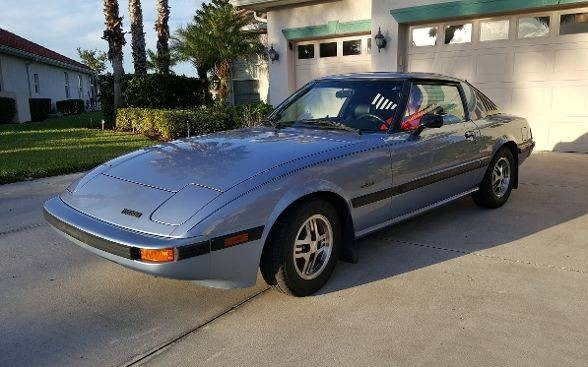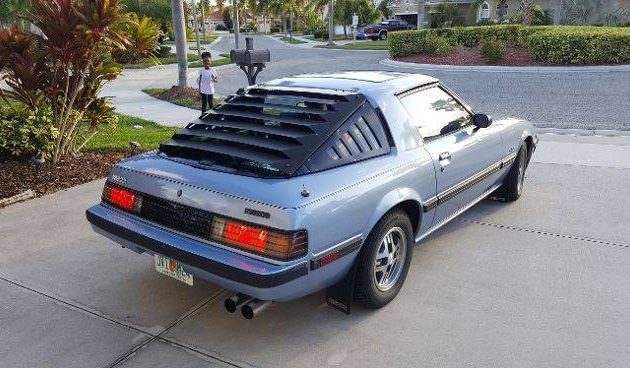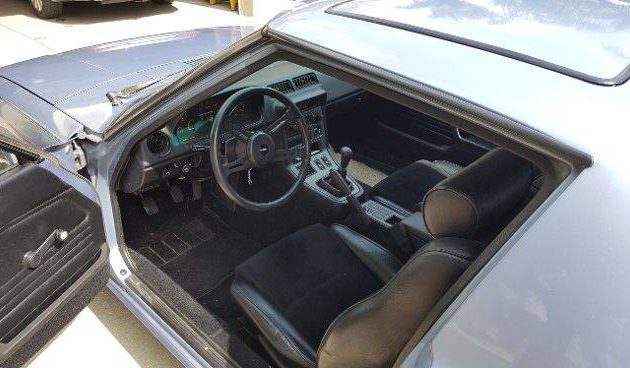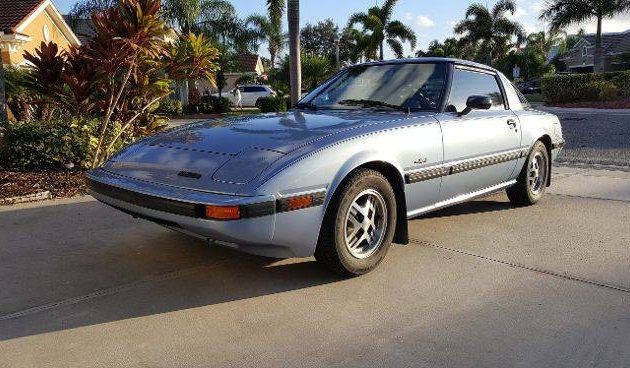Barn Finder Patrick S has located a really nice looking Mazda for us to consider, so thank you for that Patrick. This 1983 Mazda RX7 has led a fairly protected life for the last 30 years. That is how long it has been in the possession of the current owner. They have decided to part with this little classic, and you will find it listed for sale here on Craigslist. Located in North Port, Florida, it is being offered for sale with a clean title. The sale price for this RX7 has been set at $8,500.
The thing about so many cars produced during the 1970s and 1980s was that the quality of the paint and plastic trim could be pretty ordinary, and a lot of it didn’t stand the test of time if it wasn’t well cared for. This RX7 seems to have weathered the years quite well, indicating the seller’s claims about being kept in a warm garage to be quite conceivable. The paint and trim look really good, and the car has also been fitted with an optional sunroof. The factory alloy wheels also seem to be free of scratches from curb strikes, and the sort of pitting caused by brake dust.
The interior also looks good. Once again, it’s the plastic trim that is the giveaway. The trim on this little RX7 looks good. The car is also fitted with air conditioning, which is said to work well. Under the hood is the amazing little 12A Wankel rotary engine. If treated properly, these little engines could be quite reliable, if a little bit thirsty. Thankfully this one is backed by a 5-speed manual transmission. Due to the lack of engine torque, the smooth little rotary really wasn’t effective when attached to an automatic transmission, so this is the best combination.
When Mazda brought the rotary engine to the market, it suffered from some horrendous reliability issues. While there were some design flaws which were ironed out over the years, the vast majority of the problems were caused by owners lacking the knowledge about how to treat these engines. Today, there are vast volumes of books devoted to this subject. That, coupled with improvements in engine technology, have made these a reliable little engine. The early RX7 is a lightweight little car that handles and brakes incredibly well. If you want a car that is competent and fun, this would be a great car to consider.






I remember having to push start several of these…when the compression seals went bad …these are fantastic fun when running well…and were really nice handling cars.rare to see a really nice survivor.☺️ Glad there are some nice ones left…the ladies loved these cars also…which may explain why there are some really nice ones left….as they may have taken better care of them than some guys.🤔..really nice find….could be real fun…..again.!..🤔😎
These are fantastic cars that remain under-appreciated in today’s overheated classic car market. Mazda’s answer to the 240Z. The rotor-motor had issues: Apex seal failure and truly abismal fuel consumption, but an 8k redline and power-to-displacement ratio that was truly amazing.
My late older brother bought one of the middle trim level RX-7s new and when a good friend from high school days asked a mutual friend and myself to be Groomsmen in his St. Louis wedding, my brother agreed to let me drive it. My gosh that 12A Wankel rotary engine pulled strong with the 5-speed transmission. I checked the oil level every 500 miles just to be safe as I had heard those engines were designed to use a little oil. A great road trip and I made so many illegal U-turns in that city because of how the streets ran, I lost count. Fun times!
That seems like a great deal on a straight car. I always liked them and know they handle well. I think they are going to rise in value. Around here you never see one on the road
The Poor Man’s Porsche. Mine was a ’79 12A 5-speed. It was fairly strong at 20,000 miles when I bought it but began to lose a little by the time I sold it at 45,000.
Cool little cars, great handling – I’d buy another if I had the money and the room. You can’t always say that about a car you used to own.
Of course it was in a warm garage, I live 60 miles south of North Port and it does not get cold. Of course, summer is hot and plastic trm doesn’t like extreme heat or UV rays. We have a lot of cars with sunburnt paint and interiors.
I had a 1981 5 speed when I lived in Ohio. it had some plastic trim issues at 3 years of age. Fun car in the snow as it had great balance.
Funny how the lead in picture has the sun shinning at the rear end of the car. It looks like white smoke from the tail pipe! (another case of bad cooling seals? lol)
I always thought that the early cars (RX2, RX3, etc.) were the 12A engines (Twin distributor) and all the later cars (RX4, RX7) had 13B engines? (Single Distributor) Am I wrong?
I always did and still do like these cars. Smooth, clean, aerodynamic, light and rev happy. What is not to like?
I still desire one.
Wayne the 12A was the RX7 power plant until 85 ish. I auto crossed and track dayed an 83 GSL for many years. If you have the option the GSL is the way to go, factory 4 wheel disc and limited slip rear standard. Mine was a Colorado car so the plastic bits on the interior literally disinagrated when touched, too much time in the sun. I ran it in CSP so exhaust, intake, suspension, and tires were open to mods. I put a intake, larger 4 barrel, headers, and open 3″ exhaust. I described the sound as a pack of chainsaws on steroids. It had a shift chime at around 7500 RPM. I blew past that so often it finally called it quits. Fun car, another one I wish I kept
The upper level GSL-SE got the 13B engine for a couple of years at end of the first generation body style, while the base model remained motivated by the 12A. Subsequent Rx-7s we’re 13Bs.
I apologize for repeating these comments so many times whenever Gen1 RX7 are mentioned. But my ’82 is running strong at 120k miles and gets 22 mpg. Lot’s of fun and very reliable. These engines have an oil metering system which adds some engine oil to the intake (in a piston engine oil passes by the rings and valve stems). I have never had an issue with the metering system, but for unknown reasons other people do have issues. The oil never really gets dirty because the rotary does not have combustion blow-by into where the oil resides. Of course I change the oil about twice a year (much more often than the miles recommended in the manual). I agree that the 5 speed is the way to go (it really does not make any sense to put an automatic behind a rotary). I am curious about the rear window louvers, they are identical to the ones that were on mine. I do not know if the louvers were aftermarket or original. I removed mine after a tree branch fell on the back window (They could be repaired and if someone is looking for a set, please contact me). By the way 1980 to 1985 was the lean burn 12A engine to the best of my knowledge. Please correct me if I am wrong. But if you are Rota-phobic they is no need to comment.
I never heard of a lean-burn 12A (lean burn was a Chrysler term, IIRC), but the carbureted 12A was the Rx-7 engine from ’79-’85, except for the 1984/85-only GSL-SE, which used a fuel-injected 13B rated at 135 horsepower.
Just about all manufacturers had some form of “lean burn” in the late ’70s or early ’80s. For the Mazda rotary, it was just some changes to the exhaust. Some years were “thermal reactor” some were catalytic converters. Of course, leaner carburetor jetting went along with this. The whole purpose was reduced emissions and hopefully a few more mpg. I would not be surprised if Chrysler or other manufacturers tried to capitalize on marketing this term.
I had an 82 manual trans car with a crank open sunroof ! The little rotory would wind up to 8000 rpms . Quick fun little car . With some wider tires and a little suspension work it was a great handler !